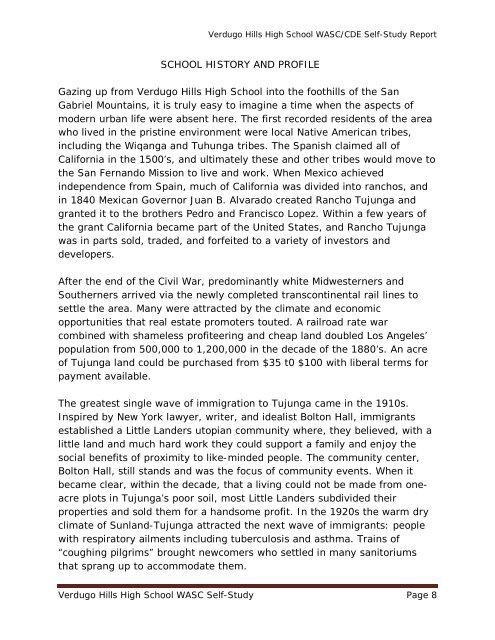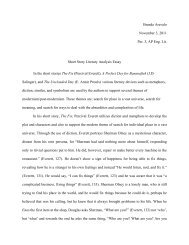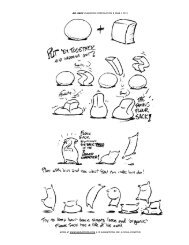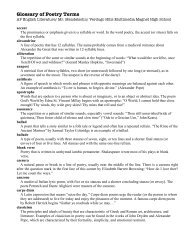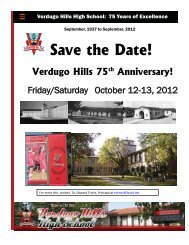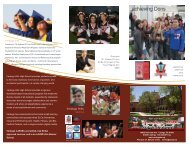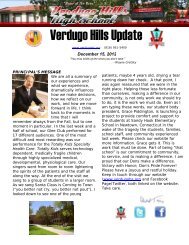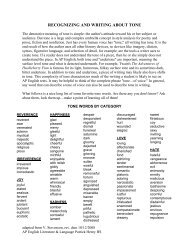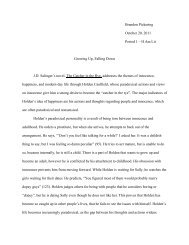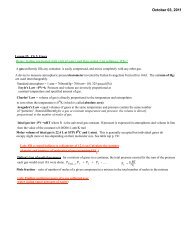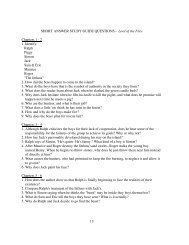Verdugo Hills High School WASC Self-Study Page 1
Verdugo Hills High School WASC Self-Study Page 1
Verdugo Hills High School WASC Self-Study Page 1
- No tags were found...
Create successful ePaper yourself
Turn your PDF publications into a flip-book with our unique Google optimized e-Paper software.
<strong>Verdugo</strong> <strong>Hills</strong> <strong>High</strong> <strong>School</strong> <strong>WASC</strong>/CDE <strong>Self</strong>-<strong>Study</strong> ReportSCHOOL HISTORY AND PROFILEGazing up from <strong>Verdugo</strong> <strong>Hills</strong> <strong>High</strong> <strong>School</strong> into the foothills of the SanGabriel Mountains, it is truly easy to imagine a time when the aspects ofmodern urban life were absent here. The first recorded residents of the areawho lived in the pristine environment were local Native American tribes,including the Wiqanga and Tuhunga tribes. The Spanish claimed all ofCalifornia in the 1500’s, and ultimately these and other tribes would move tothe San Fernando Mission to live and work. When Mexico achievedindependence from Spain, much of California was divided into ranchos, andin 1840 Mexican Governor Juan B. Alvarado created Rancho Tujunga andgranted it to the brothers Pedro and Francisco Lopez. Within a few years ofthe grant California became part of the United States, and Rancho Tujungawas in parts sold, traded, and forfeited to a variety of investors anddevelopers.After the end of the Civil War, predominantly white Midwesterners andSoutherners arrived via the newly completed transcontinental rail lines tosettle the area. Many were attracted by the climate and economicopportunities that real estate promoters touted. A railroad rate warcombined with shameless profiteering and cheap land doubled Los Angeles’population from 500,000 to 1,200,000 in the decade of the 1880’s. An acreof Tujunga land could be purchased from $35 t0 $100 with liberal terms forpayment available.The greatest single wave of immigration to Tujunga came in the 1910s.Inspired by New York lawyer, writer, and idealist Bolton Hall, immigrantsestablished a Little Landers utopian community where, they believed, with alittle land and much hard work they could support a family and enjoy thesocial benefits of proximity to like-minded people. The community center,Bolton Hall, still stands and was the focus of community events. When itbecame clear, within the decade, that a living could not be made from oneacreplots in Tujunga’s poor soil, most Little Landers subdivided theirproperties and sold them for a handsome profit. In the 1920s the warm dryclimate of Sunland-Tujunga attracted the next wave of immigrants: peoplewith respiratory ailments including tuberculosis and asthma. Trains of“coughing pilgrims” brought newcomers who settled in many sanitoriumsthat sprang up to accommodate them.<strong>Verdugo</strong> <strong>Hills</strong> <strong>High</strong> <strong>School</strong> <strong>WASC</strong> <strong>Self</strong>-<strong>Study</strong> <strong>Page</strong> 8


